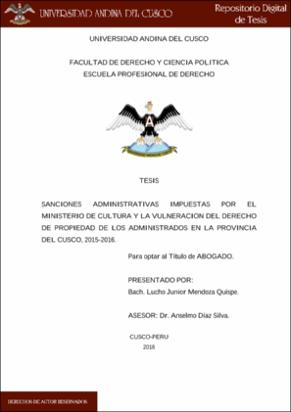| dc.contributor.advisor | Díaz Silva, Anselmo | |
| dc.contributor.author | Mendoza Quispe, Lucho Junior | |
| dc.date.accessioned | 2017-11-29T14:39:21Z | |
| dc.date.available | 2017-11-29T14:39:21Z | |
| dc.date.issued | 2016-12-21 | |
| dc.identifier.uri | https://hdl.handle.net/20.500.12557/1120 | |
| dc.description.abstract | El presente trabajo sobre la vulneración de la propiedad de los administrados es una problemática que viene desarrollándose en la provincia del cusco, quizá no con todos los administrados en general, pero si con los ciudadanos que viven en la zona del parque arqueológico de Sacsayhuaman. Quizá esta problemática no se notaba con facilidad, pero la población que vive en la zona empezó a poner, a través de marchas, en conocimiento de la colectividad el abuso que cometen con ellos las autoridades del sector cultura; indican que a la mínima mejora que le realicen a sus viviendas se les sanciona con multas o con la destrucción de sus inmuebles, muchos de ellos son considerados como invasores, ante este hecho ellos salen a las calles y elevan su voz de protesta a lo que ellos consideran un abuso de autoridad; Ante esta problemática empiezo a formularme la siguiente interrogante ¿de qué manera las sanciones administrativas impuestas por el ministerio de cultura vulneran en los administrados su legítimo derecho a la propiedad?; es por ello que, a través del
presente trabajo se encontrara posibles soluciones al problema. Para ello también se planteó la siguiente hipótesis: Las sanciones administrativas impuestas por el ministerio de cultura vulneran directamente el derecho de propiedad de los administrados que han realizado construcciones en sus inmuebles. De la misma manera se tuvo como objetivos analizar si las sanciones administrabas son proporcionales con la infracción; y, determinar
si las sanciones administrativas sirven como medio para preservar y defender el patrimonio cultural. Para poder alcanzar los objetivos de mi investigación, se realizó un trabajo de carácter exploratorio y se utilizó técnicas e instrumentos para que coadyuven a la realización del trabajo. Por ejemplo una técnica que se empleó en el trabajo de investigación fue la encuesta con su instrumento de medida que fue el cuestionario, que se les realizo a unas 50 personas que viven alrededor de las zonas intangibles de la provincia del cusco. | es_PE |
| dc.description.abstract | The present work on the violation of the property of the administrated is a problematic that is developing in the province of Cusco, maybe not with all the administered in general, but if with the citizens who live in the area of the archaeological park of Sacsayhuaman.
Maybe this problem was not easily perceived, but the population living in the area began to put, through marches, to the collective knowledge the abuse committed by them with the authorities of the culture sector; Indicate that the minimal improvement that they make to their homes are punishable by fines or the destruction of their property, many of them are considered as invaders, before this they take to the streets and raise their voice of protest to what They consider it an abuse of authority; Faced with this problem, I begin to ask myself
the following question: how do administrative sanctions imposed by the Ministry of Culture violate the legitimate rights of property owners? It is for this reason that, through the present work, possible solutions to the problem will be found. To this end, the following hypothesis was also raised: The administrative sanctions imposed by the Ministry of Culture directly violate the property rights of the administrators who have built their buildings. In the same way, the objective was to analyze if the administrative sanctions are proportional to the infraction; And determine whether administrative sanctions serve as a means of preserving and defending cultural heritage. In order to achieve the objectives of my research, an exploratory work was done and techniques and instruments were used to help the work. For example, one technique that was used in the
research work was the survey with its instrument of measurement that was the
questionnaire, which was made to about 50 people living around the intangible areas of the province of Cusco. | en_US |
| dc.description.uri | Tesis | es_PE |
| dc.format | application/pdf | es_PE |
| dc.language.iso | spa | es_PE |
| dc.publisher | Universidad Andina del Cusco | es_PE |
| dc.rights | info:eu-repo/semantics/openAccess | es_PE |
| dc.rights.uri | https://creativecommons.org/licenses/by-nc-nd/2.5/pe/ | es_PE |
| dc.source | Universidad Andina del Cusco | es_PE |
| dc.source | Repositorio Institucional - UAC | es_PE |
| dc.subject | Propiedad | es_PE |
| dc.subject | Vulneración | es_PE |
| dc.subject | Viviendas | es_PE |
| dc.subject | Sanciones administrativas | es_PE |
| dc.title | Sanciones administrativas impuestas por el Ministerio de cultura y la vulneración del derecho de propiedad de los administrados en la provincia del Cusco, 2015-2016. | es_PE |
| dc.type | info:eu-repo/semantics/bachelorThesis | es_PE |
| thesis.degree.name | Abogado | es_PE |
| thesis.degree.grantor | Universidad Andina del Cusco. Facultad de Derecho y Ciencia Política | es_PE |
| thesis.degree.level | Titulo Profesional | es_PE |
| thesis.degree.discipline | Derecho | es_PE |


